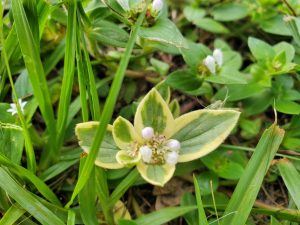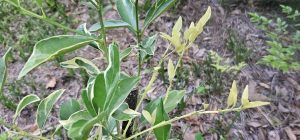An interesting phenomenon turned up in my camellia this spring. What has, for years, been a perfectly normal bush – growing its glossy, dark green leaves year ‘round and its showy flowers in the fall – suddenly changed. Its leaves started becoming variegated!
Variegation refers to different colored areas of plant tissue. Most commonly, a plant will have stripes or patches of white leaf tissue along with the normal green. Sometimes, colors can vary or the placement can include stems or fruit. Many cultivated varieties of ornamental plants are selected for these interesting patterns, and sometimes food crops as well. A novel, attractive pattern can make for a very profitable plant. In the 1630s, the price of variegated tulips skyrocketed for several years in the Netherlands. During this period of ‘tulip mania’, a single tulip bulb could potentially sell for ten times the annual income of a skilled artisan. Imagine paying $200,000 for one flower!
Some variegations are caused by genetic mutations. Plants that are chimeras have cells with different genetic makeups. These varieties must be propagated by cutting or grafting to preserve both sets of genes. Even if successfully propagated, sometimes individual leaves or branches of these plants might lose one color or the other. A leaf that is completely white won’t thrive; it contains no chlorophyll, which gathers energy from sunlight. A leaf that becomes completely green may outcompete the rest of the variegated plant, leading to a loss of variegation over time.
Other variegations, such as those Dutch tulips and my camellia, are caused by viruses. Most are not desirable, as they decrease the health of the plant even if they don’t kill it outright. Others will quickly lead to decline and death. A mosaic virus, for example, might make your tomato leaves look interesting, but it will eventually kill the plant. In the case of a camellia, ‘camellia yellow leaf mottle virus’ is usually transmitted during the propagation or grafting process, whether intentionally or not. Camellias affected by this virus are usually not harmed, though a lack of chlorophyll in leaves leads to less energy for the plant to use in growth and producing flowers. Still, sometimes the tradeoff for fancy foliage is worth it!
My camellia must have received a bug bite that transmitted the virus, as I haven’t done any grafting on it. I’ve noticed a few others nearby with similar symptoms. If you see this starting on your plant, you may be able to prune out the affected area before it spreads. Make sure to sanitize pruning equipment with alcohol between cuts, and dispose of infected material if you do remove it. For other unwanted viruses, the solution may be a bit more extreme. If you cannot prevent infection in the first place through sanitation and insect control, disposal of the entire plant is often the only option that will keep the virus from spreading to other nearby plants. For any plant disease or pest issue, scout regularly and address the issue before it becomes too big. Consult your local Extension office for information or check out our EDIS publications on specific topics at https://edis.ifas.ufl.edu/.
- Quercus Geminata, the Sand Live Oak - November 20, 2025
- Snakes of the Panhandle - October 10, 2025
- Ganoderma, a Deadly Disease of Palms - September 4, 2025




